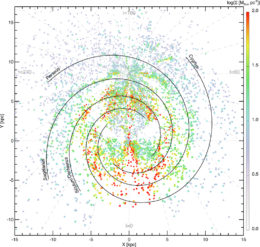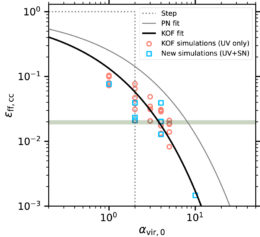For nearly 50 years, models have predicted that the Milky Way should be forming new stars far faster than it currently is. Can a reassessment of our models solve this long-standing mystery?
Stymied Star-Formation or Mistaken Models?

The Milky Way hosts thousands of clouds of molecular gas — the sites of star formation. This map shows the locations and surface densities of molecular hydrogen clouds with a map of the Milky Way’s spiral arms on top. [Miville-Deschênes et al. 2017]
Theorists have suggested that magnetic fields, turbulence, and massive stars injecting energy into their natal clouds suppress the Milky Way’s star-formation rate, but these solutions require unrealistically strong magnetic fields and constant, widespread turbulence. And this star-formation conundrum extends beyond the Milky Way — studies have found that models predict a speedier star-forming rate for our galactic neighbors as well. What might be amiss with our models?
A Milky Way Mystery
A team led by Neal Evans (University of Texas at Austin) approached this long-standing problem by considering the two main quantities that determine a galaxy’s star-formation rate: the masses of molecular gas clouds and how efficiently they form stars.

Plot of the efficiency with which molecular clouds collapse into star-forming cores per unit freefall time as a function of the virial parameter, αvir, which describes whether the cloud is gravitationally bound. (A high αvir value indicates that the cloud is not gravitationally bound and thus forms stars less efficiently.) The blue squares represent the new simulations from this work. The shaded green area indicates a constraint from observations. [Evans et al. 2022]
The authors also considered how to improve our estimates of the star-formation efficiency — the fraction of gas in a star-forming cloud that eventually forms stars. Simple models of star formation assume that all gravitationally bound clouds will be entirely converted into stars, while those that are not bound won’t form any stars at all. However, the authors posit that star-formation efficiency likely varies from cloud to cloud rather than being all or nothing. To capture this subtlety, they developed a framework in which turbulence, high-energy radiation from newly formed stars, and energy injected by supernovae moderate the star-formation efficiency.
Closing In on a Solution

Star-formation rate surface density as a function of distance from the galactic center. Observational estimates are shown in magenta. The numbers in parentheses give the total star-forming rate of each model in solar masses per year. [Evans et al. 2022]
Citation
“Slow Star Formation in the Milky Way: Theory Meets Observations,” Neal J. Evans II et al 2022 ApJL 929 L18. doi:10.3847/2041-8213/ac6427
